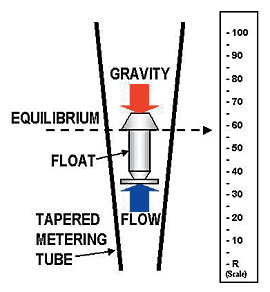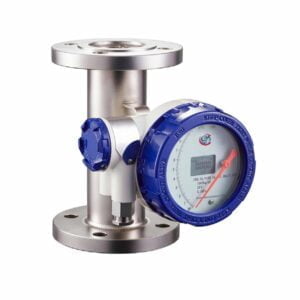The variable area flow measurement technique is one of the oldest known and widely-recognized flow measurement principles. As such, variable area flowmeters, sometimes also known as rotameters, have one of the largest install bases of any flow measurement technology that is being sold today. Key advantages of this technology are that it is reliable, easy to install, and easy to read. These meters are also commonly chosen because the measurement technique is mechanical in nature and may be deployed in situations where there is no power available.
VA meters are one of the oldest-known flow measurement techniques with a large install base, and variable area meters are found in various industries where liquid and gas flows are being measured. Variable area meters all share the same basic design elements – a flow body that consists of a tapered glass or clear plastic tube or a cylindrical metal tube flow meter with an internal tapered metering pin, an internal moving float or orifice plate, and a printed scale that provides the flow rate reading.
The volumetric flow rate through the flow body is proportional to the displacement of the float. When a fluid flows through the tube from bottom to top, it causes a relatively constant pressure drop across the float, which produces an upward force that urges the float upward toward the top of the tube. Increases in flow rate are directly proportional to the square of this pressure drop.

Water & Energy flowmeters from SmartMeasurement have been successfully installed in a wide variety of industries and applications including:
Variable Area flow meters are inexpensive and easy to install and require no power as it is a purely mechanical message. Another advantage is that they are capable of measuring both liquids and compressed gasses. However, if the VA meter is making use of a gravity return to urge the float back towards the zero position rather than a spring return, then it must be installed in a vertical orientation with the flow tube perpendicular to the base. When the vertical installation is not possible, a meter having the spring return must be used. VA meters are calibrated with water for liquids and air for gasses. For applications involving fluid media other than water or air, the flow scales are corrected based on the operating density of the alternate fluid. The gases or corrosive liquids flow rates are read by aligning the top of the float with the tick mark on the flow tube. However, a change in operating parameters will compromise the meter’s accuracy, forcing it to be returned to the factory for recalibration. In general, the average accuracy of a variable-area flowmeter is ±2-4% of full-scale flow.
In applications where there are no power requirements, a mechanical dial is enough to offer instantaneous fluid measurement. A user can easily read the gas or liquid flow rate from either a scale next to the tube or a scale on the tube. Since power isn’t necessary, users can install the ALVAMT in hazardous and remote areas where it is expensive to supply power.
Flow measurement with Smart Measurement ALVAMT variable flowmeter is always the most common and suitable solution when it comes to measuring low flow rates of clean liquids or gases, and when economy and compact installation take priority over maximum accuracy.
Please visit our industrial measurement applications section to find more detailed information about where our Variable Area flow meters have been successfully used.
Request a quote for Variable Area flow meters for your application or contact Smart Measurement to learn more.
The major advantages of SmartMeasurement’s ALVAMT variable-area flowmeter include its relatively low cost and its’ ease of installation. Its simplicity of design lends to low maintenance operation and hence, long service life. These meters also offer flexibility in different applications with a wide flow range of chemicals. With the PTFE-lined metal tube construction, variable area meters can resist corrosive damage from aggressive chemicals.
The ALVAMT variable area meter does not require power and will provide accurate flow rate readings much like a glycerin-filled pressure gauge reads pressure readings without any electrical power. This allows the meter to be deployed where it is not practical or possible to run a power cable.
A standard glass tube rotameter, or variable area flowmeter, measures the flow rate of liquids and compressed gasses by relating the position of an internal float to a corresponding flow rate on a printed scale. As the flow rate increases, pressure differential across the float also increases. This causes the float to be urged upwards toward the top of the scale. This upward motion is opposed by gravity and the mass of the float until the float reaches a point of equilibrium, at which time the float’s position my be read against the printed scale. As the float moves upwards, the area of the orifice that is formed between the float’s outside diameter and the inside diameter of the tapered tube increase – hence the term “variable area”. The increase in the orifice area that the flow travels through is proportional to the square of flow rate.


The brand name Rotameter was registered by the British company GEC Elliot automation, Rotameter Co. In many other countries the brand name Rotameter is registered by Rota Yokogawa GmbH & Co. KG in Germany which is now owned by Yokogawa Electric Corp.
Metal tube variable area meters are used when the operating pressure is too high for a glass tube or when a horizontal rather than vertical mounting orientation is required. This style of variable area meter will typically feature a flow body that is machined from either stainless steel, aluminum, or brass. The position of the internal float is determined by reading the position of a needle that is mechanically coupled to the internal float or magnetically coupled follower that can be read from the outside of the tube. With this type of device, the internal float is urged back towards zero-scale by a spring rather than gravity.
The use of the stainless/aluminum/brass materials of construction for the meter’s pressure vessel allows for both high temperature operation as well as use in applications with hydraulic pressure – up to 6000 psig. The spring return allows for unlimited mounting orientations – vertical, horizontal, or diagonal with no upstream/downstream straight pipe run requirement.

©2020 SmartMeasurement™ 10437 Innovation Drive, Suite 315, Wauwatosa, WI 53226
Tel: 1-414-299-3896 | Fax 1-414-433-1606 1-866-404-5415